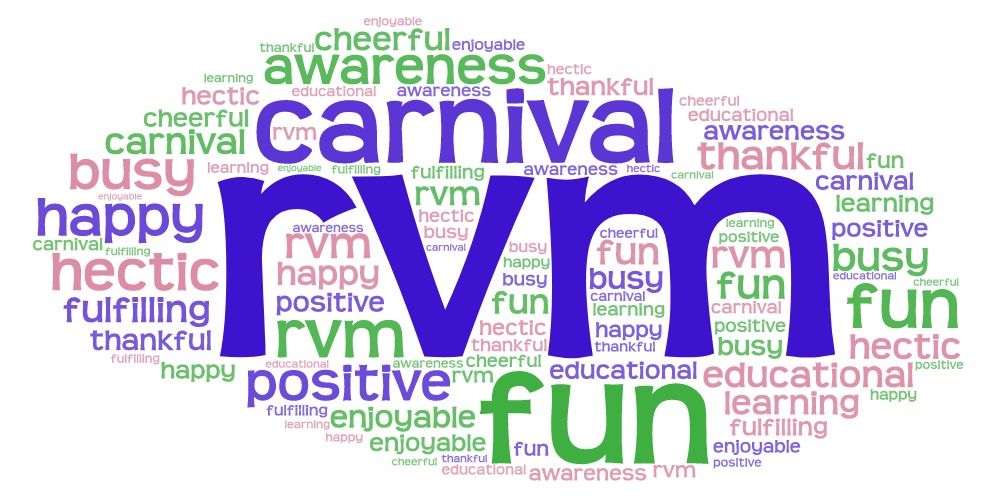
Page 6 of 11
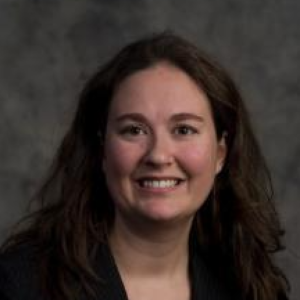 Dr. Anisa Fornoff is an Associate Professor of Pharmacy at Drake University. She is also a faculty fellow with the Office of Community Engaged Learning & Service, and enjoys working with people in the Des Moines area with disabilities.
Dr. Anisa Fornoff is an Associate Professor of Pharmacy at Drake University. She is also a faculty fellow with the Office of Community Engaged Learning & Service, and enjoys working with people in the Des Moines area with disabilities.
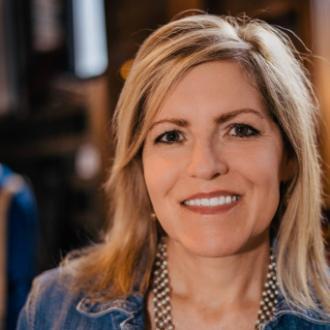
Carlyn Crowe is a Visiting Assistant Professor of Journalism and the Internship Coordinator for the School of Journalism and Mass Communication (SJMC) at Drake University. She is a Faculty Fellow of our office, and enjoys engaging her students in meaningful and thoughtful service around the Des Moines community.
By Russell White
“Before you are a leader, success is all about growing yourself. When you become a leader, success is all about growing others.” -Jack Welch, chairman and CEO of General Electric between 1981 and 2001.
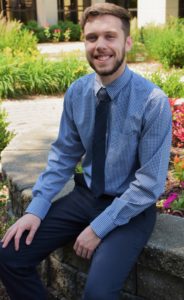 My name is Russell White and I graduated from Drake in May of 2018 with a Bachelor of Arts degree in Politics and International Relations. I currently serve as an AmeriCorps VISTA member with the Iowa Mentoring Partnership (IMP) at Volunteer Iowa. My work is related either to capacity building and sustainability for mentoring programs, or I am engaging in outreach via social media, email and phone. I am tasked with helping give technical assistance to mentoring programs and helping them create the structure their programs need to be successful in serving Iowa’s youth. Often, I get the pleasure of listening to personal stories from mentors, mentees and parents/guardians about the amazing impact mentoring has on their lives. Nothing is more fulfilling than knowing that you are helping to improve the lives of children across an entire state; knowing that you truly are making a difference it people’s lives. But, I didn’t end up at the IMP randomly, it was quite deliberate. For you see, I am passionate about youth development and mentoring. Why? Well, I myself am a mentor. I mentor a young boy named Aiden who attends Monroe Elementary School, which is not that far from Drake University’s campus.
My name is Russell White and I graduated from Drake in May of 2018 with a Bachelor of Arts degree in Politics and International Relations. I currently serve as an AmeriCorps VISTA member with the Iowa Mentoring Partnership (IMP) at Volunteer Iowa. My work is related either to capacity building and sustainability for mentoring programs, or I am engaging in outreach via social media, email and phone. I am tasked with helping give technical assistance to mentoring programs and helping them create the structure their programs need to be successful in serving Iowa’s youth. Often, I get the pleasure of listening to personal stories from mentors, mentees and parents/guardians about the amazing impact mentoring has on their lives. Nothing is more fulfilling than knowing that you are helping to improve the lives of children across an entire state; knowing that you truly are making a difference it people’s lives. But, I didn’t end up at the IMP randomly, it was quite deliberate. For you see, I am passionate about youth development and mentoring. Why? Well, I myself am a mentor. I mentor a young boy named Aiden who attends Monroe Elementary School, which is not that far from Drake University’s campus.
I began mentoring Aiden in the fall semester of 2017 of my senior year at Drake. At the time, Kerry King of Fraternity and Sorority Life (FSL) put together a new service opportunity between Drake FSL and Monroe Elementary’s afterschool program. When I first heard of this opportunity I was excited by it, mostly because I enjoy volunteering with kids; it is honestly a blast. The Spring before, a group of FSL students attended Monroe Elementary for several hours and spent time with the kids. We read them books, talked with them and even played a few games with them. Needless to say, it was perhaps one of the best ways to volunteer. So, upon hearing about this new opportunity to spend time at Monroe Elementary once a week for an hour with their afterschool program it seemed like a no-brainer! A handful of other Drake students and I signed on to be volunteers in the fall of 2017.
Upon my first visit to Monroe I was taken outside with the kids to the playground. That is when I met Yolanda Shields, the director of the afterschool program, and, as I would learn, a terrific individual to be around. After meeting her and explaining I was a Drake student here to volunteer, she quickly referred me to a student of hers that was writing a book and needed help. Since I was a college student, both her and the student thought I could lend a little bit of help. That student was Aiden. Our first day together Aiden and I sat at the base of the jungle gym and spent the entire time working on his story. At first, this might seem only like a cute activity that he and I did together on our first day. However, prior to sitting down with Aiden I was informed that Aiden has ADHD. So, sitting down for a long period of time and focusing on one particular thing doesn’t exactly come naturally to him. At the same time, he sometimes gets so hyperactive that he bounces off the walls in his classroom and causes both disruption and trouble. Sitting down with Aiden, it became clear to me that he was not at all a bad kid. He is similar to most kids his age: has a hard time with sharing, loves to play video games, has a silly sense of humor and just loves to play around. He and I hit it off on my first visit to Monroe and I had informally become his mentor.
I would go back to see Aiden most weeks; I did my best to try every week, but sometimes I could only do every other week. But every time I would walk through the door and he saw me a big smile would grow on his face. Those moments always felt rewarding. He and I would almost do the same thing whenever I came to visit him. We would go out into the hallway, sit down on the floor, I pull out my phone and we begin to watch video game clips on YouTube. At the time, Aiden’s video game obsession was a 2D dungeon/adventure/mining scroller called Terraria. Luckily, I knew of the game prior to him showing me and that excited him that I knew what he was talking about. He and I began to bond over video games and we would show each other videos and just watch them every time I visited. But, I would also get him to play some board games with me, like Candyland, Battleship and even Chess. Surprisingly a 10-year-old kid likes to play Chess.
At the same time though, I would talk with Aiden about how things are at home. How school and class was going. Just anything that was going on in his life, and he would open up more and more to me with every visit. I would also try to work with him on how he interacts with other students; teaching him to be more kind and more willing to share with his classmates. By the end of my senior year, I could already see a difference in his behavior. To see and witness the change in him was such a rewarding feeling. But, my time with Aiden also had an affect on me. It made me more responsible and considerate of others. Whenever you’re a mentor, you have to be reliable and consistent with your mentee. That consistency and reliability translated to other aspects of my life. It also just made me happier, to be honest. Being around Aiden and simply playing games, watching video games and hanging out had a real positive impact on my own mental health. It also inspired me to keep mentoring and to help spread the culture of mentoring. Because of my time with Aiden, I have become passionate about the mentoring field which is a considerable reason for why I chose to serve with the Iowa Mentoring Partnership. I still mentor Aiden to this day. In fact, I intend to see him tomorrow after work and bring in his favorite snack: Takis.
People underestimate the power and impact of mentoring. The impact of a mentoring relationship doesn’t just affect the mentee, but it affects the mentor and the parents/guardians too! In a mentoring relationship, you are helping your mentee realize THEIR potential, while the mentee is helping you realize YOUR OWN potential and worth as well. You build each other up and it is a beautiful dynamic to be a part of. You become a friend, a big brother/sister, a role model. You’re just there for them. It is as simple as that. Someone they can count on and know that no matter what, they (you) will be there. It is one of the most rewarding feelings you could ever receive in life. All the while, I only spent one hour a week with him. That is only four hours a month. Think about all of the hours you spend in a month doing practically nothing. So, let me ask you this: What will you do with your four hours? Nothing? Or change a kid’s life for the better?
By Amy Knudsen, Professor of “Homelessness in America”, SCSS 076
In putting together my class, Homelessness in America, I knew that the best way to fully understand this complicated and multi-layered problem was to provide an opportunity for service learning.
This was accomplished by connecting with community organizations that spoke to the class on a variety of topics, conducting volunteer work at local shelters and designing and implementing a class project that would educate the Drake community on the issue.
Continual reflection was utilized by journaling, speaker reflection papers and reflecting on the group work and project. In addition, I asked students to reflect on what citizenship means, do they believe that volunteering is a necessary part of community and the role of the government in responding to the issue.
We had eight speakers from local organizations speak at the class and students volunteered at Central Iowa Shelter and Services and Iowa Homeless Youth Center’s (IHYC) Outreach Center. Students cleaned, sorted donations and made tie bags for residents.
For the group project students wanted to educate the Drake community on youth homelessness and we partnered with IHYC for the project. Another class on campus, LEAD 100, was also doing a similar project so we combined our efforts. The event, held on April 18th provided a homeless simulation for students and students made tie blankets for the youth. In addition, donations of personal hygiene products were collected. Approximately 25 students attended, 17 blankets were made and several boxes of donations collected.
The success of the class was seen in the student’s reflections:
“..this class and this project have taught me so much about homelessness that I could not have gotten anywhere else. The tours and speakers helped me conceptualize what we learned in class, and this event further helped that. I hope that our project will open the eyes of other students across campus, and maybe even start to break down the stigma a lot of us have. Even if we help just one homeless person, or change one person’s mind, it’s worth it.”
“I learned a lot through this experience, in many way I did not really expect. Going into this class, I expected to learn about homelessness but I was not aware that we would able to do things that actually help out the homeless. Through the event, I learned all of the work that goes behind planning a large donation event like this and just how difficult it can be to gather support for the issue you are trying to address. That is something that shelters and nonprofits face every day and I was extremely unaware of that. The simulation at the event also helped enforce the ideas that I had learned in class. I became aware of just how unpredictable homelessness is and how you can be faced with large obstacles at every turn that completely turn your world upside down.”
“Through this semester, I feel like I have learned a lot about myself. I’m sure that all freshman say that as they leave their first year of school but I feel that this class has really helped with my own internal growth. I learned about my passion for volunteering. I volunteered when I had the time in high school but seeing all this injustice brought to light around me has made me want to step up and do more. Volunteering makes a big difference in so many people’s lives and I’m sad that I haven’t done more of it until now. I have already set up a monthly volunteering spot at a local homelessness shelter back home and at the local food shelf so I’m eager to get home and help out even more. I have also learned how to better work in a group setting. I worked with groups of people I didn’t know a lot this semester and it really helped me grow a lot as a person.”
“The most important thing that I have learned throughout this experience is the crisis of youth homelessness and how it can affect education. As someone who grew up in a stable household I never considered how hard it would be to have to move schools all the time because you didn’t have a stable home. The effect of these moves on a person’s education was something that I had not considered and had never really thought about. I also never considered how hard it would be to access personal hygiene as a homeless youth. Most schools have showers in the locker rooms, but if a person is constantly switching schools or even no longer attending school this does not help them. Along with that most people donate clothing of food items and not pads and tampons or other more expensive and less socially glorified items that are necessary for women to have and use.”
Benjamin Franklin once said, “Tell me and I forget. Teach me and I remember. Involve me and I learn.” And I think this was true this semester.-
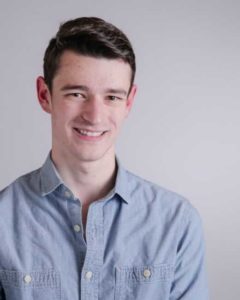 Alright, so quick introduction, I’m Tate Clemen. Currently, I’m pursuing a B.S.B.A in Accounting and Finance and a B.A. in Theatre, and I’m originally from the Kansas City area.
Alright, so quick introduction, I’m Tate Clemen. Currently, I’m pursuing a B.S.B.A in Accounting and Finance and a B.A. in Theatre, and I’m originally from the Kansas City area.
So, last year as I was making my second round of visits to Drake, I was talking with my admissions counselor, Evan, and we were discussing different scholarships that Drake offered. The Engaged Citizen Corps (ECC) came up, and, being so involved in service, I thought I’d look into it a little more. I ended up applying and got an interview with Amanda. In the car, on the way home from my third and final visit to Drake, I got the email that I had been accepted. That was one of the things that helped to secure the deal for me.
At the beginning of the year, we started the first part of the in-class section of the programs with FYS 024, “The Common Good,” which consisted of only the nine members of the ECC. This class was centered around Robert Lupton’s book Toxic Charity. Lupton’s book is a critique of the charitable industry, and shows the need for organizations that eliminate dependency and are sustainable. The ideas of his book had always been in the back of my head, but once put in words and examples, it was easy to see he was right. But this knowledge especially helped when transferring it to our worksite.
After a short “speed-dating” style of interviews with each partner site, I was paired with the Des Moines Music Coalition (DMMC). The DMMC is a Des Moines based non-profit whose main goal is to turn Des Moines into a “music city” through education and various advocacy projects. Their most known project is the implementation of the 80/35 Music Festival every July.
Going into the internship I had virtually no expectations, because I knew that it wouldn’t matter what work I was doing as long as I had the passion for cause, which I found with the DMMC. I soon discovered that I would be working as a Digital Marketing and Communications intern, working on various projects around the office, everything from designing and producing a new website to reorganizing our storage unit. The Music Coalition is quite a bit different than the other organizations the ECC works with, because they do not necessarily deal with what one would usually see as a “social problem” like poverty or homelessness, but instead the untapped potential of the Des Moines music and art scene. When people think of Des Moines, their minds usually don’t go straight to music, as it might with Nashville or New York. Due to this mission, my work with the Des Moines Music Coalition has helped me integrate myself into the Des Moines community, and further my understanding of the art scene in the city, and the struggles that it holds.
In my time with the DMMC, it has become very apparent that the government within Des Moines is limiting the growth of the scene. This is currently an ordinance within the city limits that dictate that if a music venue’s revenue is over 50% alcohol sales, then anyone under 21 is not allowed in after 9pm. This highly limits smaller venues like Lefty’s or the Vaudeville Mews from fulfilling their potential. A majority of Drake’s population is under 21, and with Lefty’s being within walking distance from campus, there is a huge market that cannot be tapped due to Des Moines’ ordinance. It was important to first understand what was happening within the music scene, and then I was able to see the DMMC’s vision and mission.
One of the largest projects that I’ve worked on is the Music Coalition’s new website. Jarin, the executive director, wanted to completely overhaul the old website and wanted something that resonated more with our target market. The old website read as “a nonprofit website,” and we wanted to cater to where a majority of the DMMC’s patrons reside, in the younger, millennial generation. We wanted to represent a feeling and an idea, a feeling of fun and of what we are truly about.
This experience has really helped me to get a greater grasp of the Des Moines community, and the need for the presence of art in the form of music within the city. It has also given me the opportunity of seeing the inner workings of how a nonprofit works. Almost all of my prior experience with the nonprofit industry was on the front lines, what is referred to as “direct service,” what people would usually think of when talking about volunteer work. But very seldom do people get to see the behind the scenes of an organization. This program has helped me apply what I’m learning in class to “the real world,” and helped expand my views of the world and the nonprofit industry.
“Art is the only serious thing in the world. And the artist is the only person who is never serious.”
― Oscar Wilde
Written by: Tate Clemen
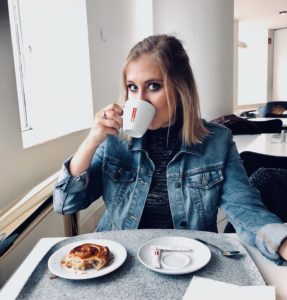 Hi! I’m Emily Larson. I’m the Service Learning Ambassador for IRIS, the Iowa Radio Reading Information Service. I’m a sophomore News, Magazine, and Writing major. As a student in the J54 class, I read for IRIS. I loved the impact such a simple service was having on the community. Reading the news for the blind and print handicapped helps people all over Iowa. And all I had to do was go to the basement of Meredith Hall and read the Council Bluff’s Daily Nonpareil! The first time I read I was super nervous. I figured I’d mess up and ruin the news for all those people. But with the help of the SLA who trained me, I read for an hour and enjoyed it. The worst part was that I forgot a water bottle and my voice was pretty sore afterwards. Now, when I train students, I always tell them to bring water—it’s a lot of reading after all. Students from the J54 class read for IRIS as a requirement of the course, but I like to make it more than that. Service isn’t about what you’re getting, a grade, it’s about what you’re giving. I try to stress that during trainings. In the booth, I tried to spice things up with a couple posters. One of them is a “5 W’s of IRIS” poster that reminds students of why they’re doing what they’re doing and who it’s for, and a whole lot of sparkle. The other one is a “reflection” poster. After they’re done reading, students can take a popsicle stick and draw a little face on it and put it on an outline of Iowa, representing someone in Iowa they’ve helped that day. It’s cheesy, but I think little things like the posters and upbeat training sessions remind the students that what they’re doing is important. They’re not just reading into a microphone in a booth in the basement, they’re actually helping real people.
Hi! I’m Emily Larson. I’m the Service Learning Ambassador for IRIS, the Iowa Radio Reading Information Service. I’m a sophomore News, Magazine, and Writing major. As a student in the J54 class, I read for IRIS. I loved the impact such a simple service was having on the community. Reading the news for the blind and print handicapped helps people all over Iowa. And all I had to do was go to the basement of Meredith Hall and read the Council Bluff’s Daily Nonpareil! The first time I read I was super nervous. I figured I’d mess up and ruin the news for all those people. But with the help of the SLA who trained me, I read for an hour and enjoyed it. The worst part was that I forgot a water bottle and my voice was pretty sore afterwards. Now, when I train students, I always tell them to bring water—it’s a lot of reading after all. Students from the J54 class read for IRIS as a requirement of the course, but I like to make it more than that. Service isn’t about what you’re getting, a grade, it’s about what you’re giving. I try to stress that during trainings. In the booth, I tried to spice things up with a couple posters. One of them is a “5 W’s of IRIS” poster that reminds students of why they’re doing what they’re doing and who it’s for, and a whole lot of sparkle. The other one is a “reflection” poster. After they’re done reading, students can take a popsicle stick and draw a little face on it and put it on an outline of Iowa, representing someone in Iowa they’ve helped that day. It’s cheesy, but I think little things like the posters and upbeat training sessions remind the students that what they’re doing is important. They’re not just reading into a microphone in a booth in the basement, they’re actually helping real people.
Hi everyone!
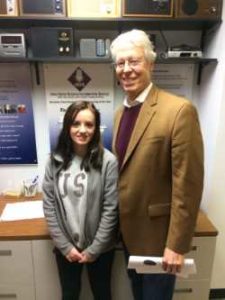
Following my acceptance to Drake University in 2016, I had mail coming from the university almost every week. Pamphlets, brochures and flyers all began piling up on my desk, but one item really caught my eye. One of the pamphlets contained opportunities for service learning at Drake and after coming from a high school with a service learning curriculum I was intrigued. Service learning had given me some of my most memorable experiences in high school, so I wanted to be able to continue service learning in high school. I decided to apply for the Engaged Citizen Corps (ECC) program that was listed in the pamphlet because the idea of being with 9 or so other first-years that were as passionate about service learning excited me. I hoped that the program would allow me the chance to make friends with other students that wanted to be engaged in their community.
Now that I am almost done with the ECC program, I feel that I have gained so much more than just friends. As part of ECC, I have had the opportunity to intern at the Iowa Radio Reading Information Service for the Blind and Print Handicapped (IRIS), which is a non-profit that reads print materials over the radio to those who would be unable to read them on their own due to blindness, visual impairment or a physical disability. Through interning with IRIS, I have made connections with people off the Drake campus and have learned about disability access. I feel that my internship with IRIS has personally popped the ‘Drake bubble’ for me because my eyes have been opened to so much that goes beyond campus life.
One of my most memorable experiences with IRIS was helping with the coordination of the Big Band Bash in the fall. I had a lot of responsibility put on me because I had to make sure the minor details of the event were taken care of prior to arrival, assist in photographing, checking people in and helping the guests. I was pretty nervous about the event, but I put all my effort into it and later my director, Maryfrances, thanked me for everything that I had done! I felt a lot more confident following the event and was able to see that although I was young that I could be a great help to my internship. I also was able to mingle amongst the guests at the event, many of whom are blind or print handicapped. Through this interaction, I was able to learn more about the blindand print handicapped community in Iowa and really understand the importance of the service that IRIS was offering them. Many of the guests exclaimed their thankfulness for IRIS which made me realize the importance of disability access.
While the Big Band Bash stands out in my mind, a lot of my time at IRIS has been spent doing more “behind-the-scenes’ work. As an intern, I am tasked with the responsibility of making the organization run smoother and often that means getting things ready for the director. I have played around with a lot of different software programs, tinkered with radios and made tons of excel spreadsheets. While initially I did not see the importance of the work that I was doing, I began to see how important it was to my director. As I worked on small projects, it saved her time and she was able to do more things important to running the organization like applying for grants. I’ve realized that when you’re working the small tasks may seem unimportant, but they contribute to the larger goal of the organization.
The other component of the ECC program outside of the internship is the curriculum at Drake. As an ECC member, I have taken a seminar class specific to ECC each semester, an FYS about the common good, and am currently in a Sociology class about social problems. In the FYS, we read Toxic Charity and discussed the importance of service that empowers those who you are serving. I was able to draw connections between what I was learning in the classroom and what the work of IRIS was doing. I saw how IRIS empowered its listeners by giving them access to information that they would be unable to do on their own. Using this information, they could make informed choices about politics, their community, current events and even know what the deals are in the grocery store! I also formed strong bonds with the other ECC members through talking about our personal beliefs and experiences. My personal beliefs were challenged and opened through our dialogue.
I am grateful for my experience in the ECC program and plan to continue my service-learning next year as the Student Learning Ambassador for IRIS at Drake. I hope to spread more information about the importance of disability access and encourage other students to become involved with the work that IRIS is doing. I hope to expand on what I have already learned through ECC and continue to grow as both a student and a public servant to my community. I hope that next year’s class of ECC students have the same great experience that I had!
Written by: Katie Carlton
 What is randomness? We all have some preconceived notion for what it means, but how does one describe it mathematically? The purpose of this J-Term (The Many Faces of Randomness) was to look at a few uses for concept of randomness, and determining what, if anything unifies them. We started out by analyzing card games, dice rolls, and coin flips. We then moved on to discussing some of the common perceptions and fallacies regarding randomness. These fallacies usually arise when people attempt to find patterns in random sequences. They range from the semi-rational “hot hand fallacy” (when a player of a particular sport seemingly increases their odds for making a shot based on their previous shots that game), to the almost entirely irrational “gamblers fallacy” (when a person is playing a game of chance and determines that, due to previous failures, they are due for a win). After touching on these topics, we moved deeper into the mathematics behind randomness. We discussed many concepts including entropy, determinism, random number generators, Kolmogorov complexity, and much more. So, I think it is safe to say that we didn’t spend the entire time drawing cards and flipping coins.
What is randomness? We all have some preconceived notion for what it means, but how does one describe it mathematically? The purpose of this J-Term (The Many Faces of Randomness) was to look at a few uses for concept of randomness, and determining what, if anything unifies them. We started out by analyzing card games, dice rolls, and coin flips. We then moved on to discussing some of the common perceptions and fallacies regarding randomness. These fallacies usually arise when people attempt to find patterns in random sequences. They range from the semi-rational “hot hand fallacy” (when a player of a particular sport seemingly increases their odds for making a shot based on their previous shots that game), to the almost entirely irrational “gamblers fallacy” (when a person is playing a game of chance and determines that, due to previous failures, they are due for a win). After touching on these topics, we moved deeper into the mathematics behind randomness. We discussed many concepts including entropy, determinism, random number generators, Kolmogorov complexity, and much more. So, I think it is safe to say that we didn’t spend the entire time drawing cards and flipping coins.
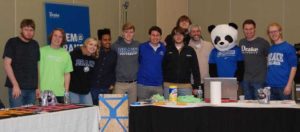
IMMAW
After spending our J-Term studying randomness, we were invited to create an exhibit for the I Make Me a World in Iowa Education Day STEM Festival. Over 1,000 middle school and high school students from across Iowa came to learn about African American culture and to explore higher education. Our class came up with four different stations for the students to interact with.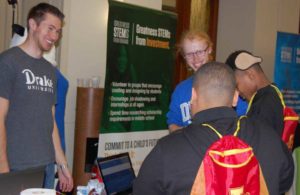
Station 1
The first station was focused on the perception of randomness. We laid out eight pieces of paper. Four of them displayed randomly generated binary strings, and the other four displayed patterned binary strings. On the back of each sheet was a statement either saying that the string was random or describing the pattern that the string held. The students task was to try to pick the random strings. This helped convey the idea that a random string may appear to have a pattern, and a patterned string may appear to be random.
Station 2
Our second station was focused on probability and randomness. We created a plinko board with twelve rows of nails and thirteen possible outcomes. In theory, the board would display a normal distribution due to the probabilities involved. All we had the students do was drop a penny into the plinko board and watch to see where it landed. It sounds simple, but the students had a great time trying to see if they could get a penny to land in a lower probability slot. By the end of the day, we had what looked to be a relatively normal distribution of pennies.
Station 3
At our third station, we let the students attempt to generate randomness. The idea was to give the students thirteen cards, all in order from Ace to King, and let them shuffle the cards until they believed they were randomly distributed. We had a computer set up that calculated how random the string the students had generated was, so they got to see firsthand how good they were at generating randomness.
Station 4
Our fourth and final station was about interacting with randomness. This station was our most popular station by far because it involved Virtual Reality. The game we created was based off of a famous way to generate a random sequence called a random walk. The basic idea is that an object in a 3D plane has six different directions it can go, and it has equal probability of going in each direction. The game involved an object moving through a 3D plane with that property, and it was the students job to shoot the object with the virtual bow and arrow. By letting the students interact with randomness through Virtual Reality, they got to learn and play at the same time.
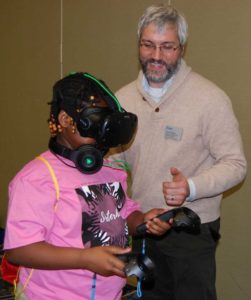
Overall, the students that visited our stations were extremely interested in what we had to offer, and they walked away with a greater understanding of randomness.
My Takeaway
I am honored to have been able to not only attend the festival, but to have run a station at our exhibit. Watching the students come to our exhibit and learn about randomness through different games was wonderful. Even better was when they asked questions. Helping educate and inspire students that were intellectually curious about mathematics and randomness made the whole event worth it for me.
Written by: Connor Ellingson
